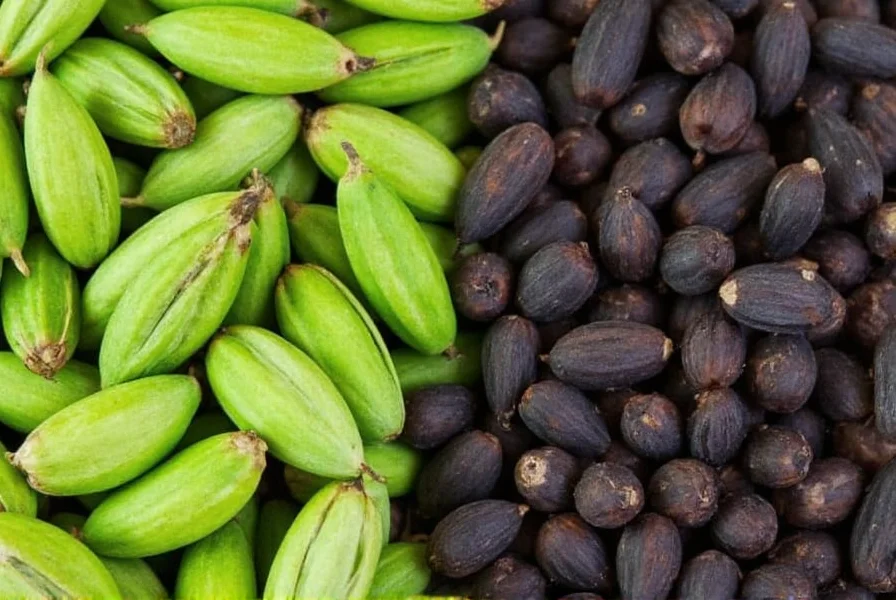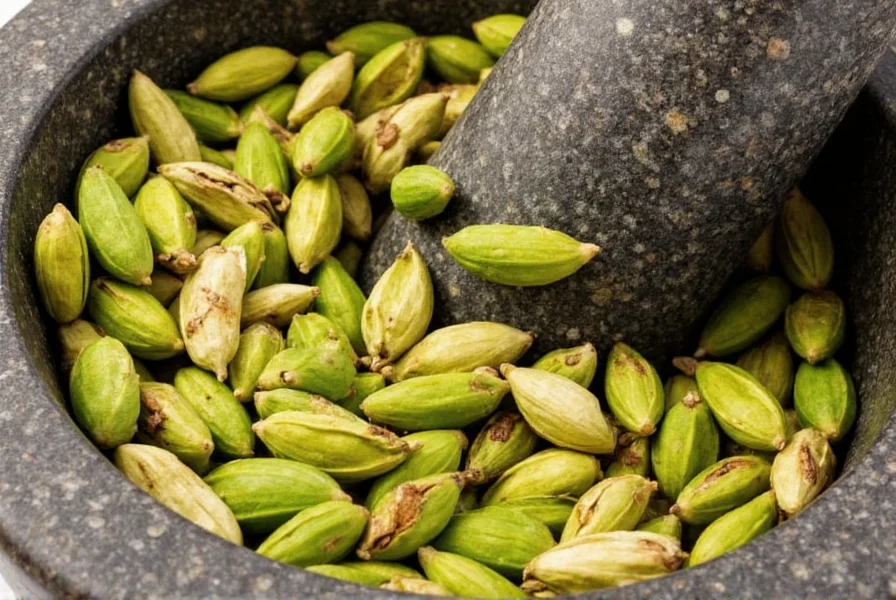Among the world's most ancient and prized spices, cardamom holds a unique position that spans continents and centuries. This aromatic seed pod has journeyed from its origins in the Western Ghats of India to become a cornerstone of diverse culinary traditions. Understanding cardamom's nuances transforms ordinary cooking into extraordinary experiences, whether you're crafting traditional chai, Scandinavian pastries, or Middle Eastern rice dishes.
Types of Cardamom: Green vs Black Varieties
Not all cardamom is created equal. The two primary varieties serve distinctly different culinary purposes:
| Characteristic | Green Cardamom | Black Cardamom |
|---|---|---|
| Botanical Name | Elettaria cardamomum | Amomum subulatum |
| Flavor Profile | Citrusy, floral, herbal with eucalyptus notes | Smoky, camphorous, menthol-like |
| Primary Growing Regions | India, Guatemala, Sri Lanka | Nepal, Bhutan, North India |
| Common Culinary Uses | Baking, desserts, chai, Persian rice | Indian curries, biryanis, Chinese five-spice |
| Heat Tolerance | Loses flavor with prolonged cooking | Improves with slow cooking |
Green cardamom represents approximately 70% of global production and features in Scandinavian baking traditions where it flavors everything from sweet buns to Christmas cookies. Black cardamom, with its distinctive smoky aroma from traditional drying methods over open fires, plays a crucial role in Indian garam masala and hearty meat dishes. Understanding these differences prevents common mistakes like substituting black for green cardamom in delicate desserts.

Historical Journey of Cardamom
Cardamom's history stretches back over 4,000 years, with references in ancient Sanskrit texts and Egyptian medical papyri. Originally cultivated exclusively in the Western Ghats of southern India, it became so valuable that ancient Greeks and Romans paid exorbitant prices for small quantities. During the Viking era, cardamom reached Scandinavia through Arab traders, where it became deeply embedded in Nordic baking traditions—a surprising culinary connection that persists today.
Guatemala now produces more cardamom than India, having adopted cultivation in the 19th century after volcanic soil proved ideal for the plants. This global journey explains why cardamom appears in such diverse culinary contexts, from Swedish kardemummabullar to Indian biryani to Omani coffee rituals.
Culinary Applications and Pairing Principles
Mastering cardamom usage requires understanding its interaction with other ingredients. The spice complements citrus flavors exceptionally well, making it perfect for orange cakes or lemon tarts. When using whole pods in rice dishes, gently crush them to release flavors without making the dish gritty. For baking applications, grinding seeds just before use preserves volatile oils that give cardamom its distinctive aroma.
Professional chefs recommend these pairing principles for optimal results when using cardamom in baking or savory dishes:
- Balance cardamom's intensity with dairy (milk, cream, yogurt)
- Combine with complementary spices like cinnamon and cloves in moderate ratios
- Use green cardamom in sweet applications and black cardamom in robust savory dishes
- Add ground cardamom late in cooking processes to preserve volatile compounds
Evidence-Based Health Benefits
While traditional medicine systems have valued cardamom for centuries, modern research provides insight into its scientifically supported benefits. Studies published in the Journal of Agricultural and Food Chemistry confirm cardamom contains potent antioxidants including terpenes, flavonoids, and polyphenols. Research from King Saud University demonstrated cardamom's potential digestive benefits, showing improved gastric motility in clinical trials.
When preparing cardamom tea for digestion, crushing 3-4 pods and steeping in hot water for 5-7 minutes maximizes beneficial compound extraction. However, claims about cardamom's ability to treat serious medical conditions remain unsupported by rigorous clinical evidence. As with any spice, benefits come from regular culinary use rather than therapeutic dosing.
Selecting and Storing Cardamom Properly
The quality difference between fresh and stale cardamom dramatically impacts final dish quality. When selecting whole pods, look for:
- Firm, plump pods that feel heavy for their size
- Vibrant green color (for green cardamom) without yellowing
- Intact husks without cracks or holes
- A strong, complex aroma when lightly crushed
Store whole pods in airtight containers away from light and heat. Properly stored, they maintain peak flavor for 9-12 months. Ground cardamom loses potency within 3-6 months, explaining why serious cooks always grind their own. For long-term storage, freezing whole pods preserves flavor compounds significantly better than room temperature storage.

Practical Tips for Cooking with Cardamom
Many home cooks make critical errors when using cardamom in recipes that diminish its impact. Follow these professional techniques:
- For rice dishes: Add whole pods during cooking, then remove before serving
- For baking: Grind seeds fresh using a dedicated spice grinder
- For beverages: Crush pods lightly to release oils without making drinks gritty
- When substituting: 10-12 pods equal approximately 1 teaspoon ground cardamom
Understanding how much cardamom to use prevents overpowering dishes. Start with 3-4 pods for a standard curry serving four people, adjusting to taste. In baking, 1/4 to 1/2 teaspoon ground cardamom typically suffices per recipe. Remember that black cardamom requires different usage considerations due to its stronger, smokier profile.
Frequently Asked Questions
Can I substitute ground cardamom for whole pods?
Yes, but with important considerations. Ten to twelve cardamom pods typically equal one teaspoon of ground cardamom. However, whole pods provide superior flavor as grinding releases volatile oils that quickly dissipate. For best results when substituting ground cardamom for whole pods, use 25% less than the recipe specifies and add it later in the cooking process.
What's the difference between green and black cardamom in cooking?
Green cardamom offers a bright, citrusy flavor ideal for sweet applications and delicate dishes, while black cardamom provides a distinctive smoky, menthol-like profile suited for robust savory dishes. They're not interchangeable—using black cardamom in baking creates an unpleasant medicinal flavor, while green cardamom lacks the depth needed for traditional Indian curries. Understanding this distinction prevents common culinary mistakes when using cardamom in different recipes.
How can I tell if my cardamom has gone bad?
Fresh cardamom should have a strong, complex aroma when pods are lightly crushed. If your cardamom lacks fragrance or smells dusty and flat, it's lost potency. Visually, green cardamom should maintain vibrant color—yellowing indicates age. Properly stored whole pods last 9-12 months, while ground cardamom deteriorates in 3-6 months. For optimal flavor in cardamom tea preparation or baking, always use fresh spice.
Does cardamom have scientifically proven health benefits?
Research confirms cardamom contains significant antioxidants and may support digestive health. Studies show compounds in cardamom can improve gastric motility and reduce inflammation. However, these benefits come from regular culinary use rather than therapeutic dosing. Claims about cardamom curing serious medical conditions lack rigorous scientific support. When enjoying cardamom tea for digestion, moderate consumption as part of a balanced diet provides the most realistic health benefits.










 浙公网安备
33010002000092号
浙公网安备
33010002000092号 浙B2-20120091-4
浙B2-20120091-4